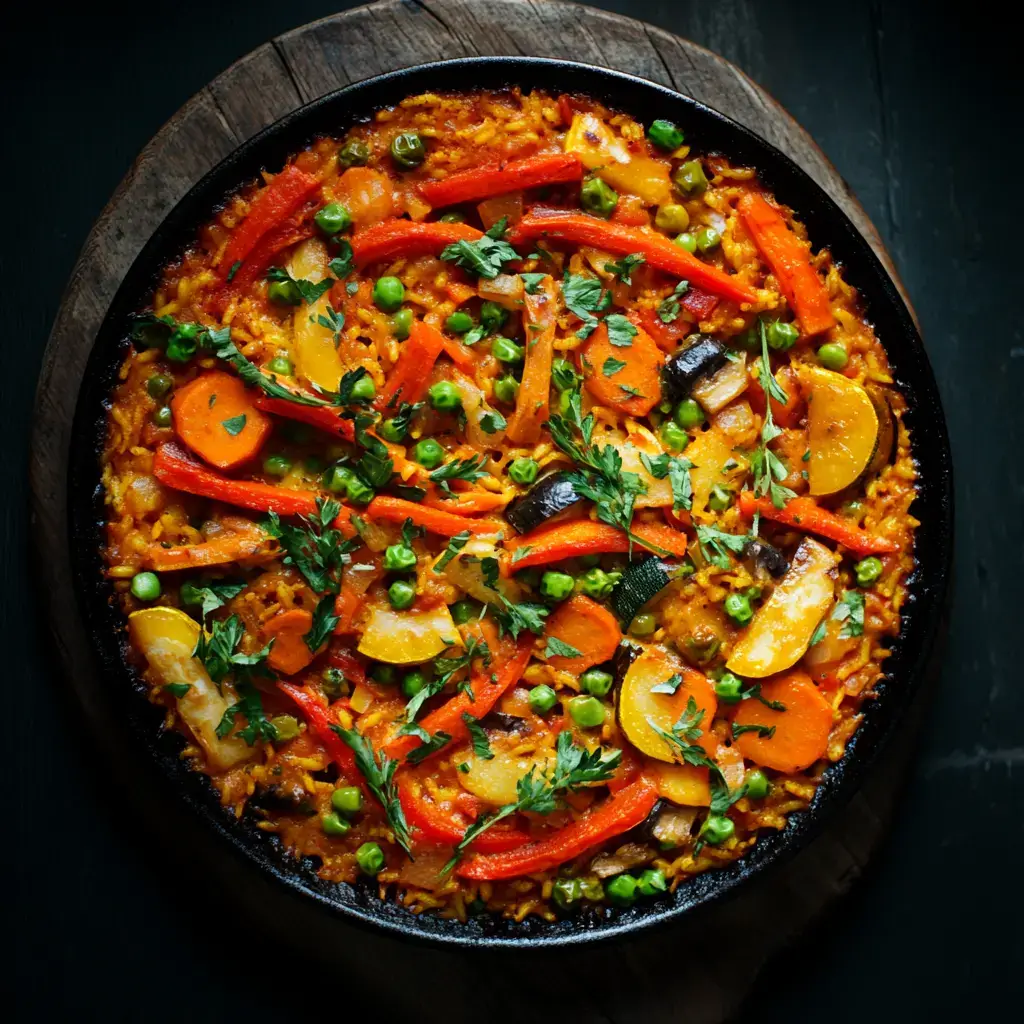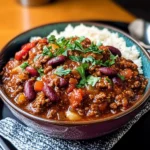Vegetable paella is a delightful twist on the traditional Spanish dish, offering a vibrant medley of flavors and textures while being entirely plant-based. Whether you’re a seasoned chef or a home cook looking to try something new, this recipe is sure to bring joy to your table. Packed with colorful vegetables and the rich taste of saffron and smoked paprika, this dish is a feast for both the eyes and the palate.
Ingredients
To create the perfect vegetable paella, gather the following ingredients:
- 1 cup Arborio rice: Known for its creamy texture, this rice is perfect for paella.
- 2 cups vegetable broth: Provides a rich base for the dish.
- 1 bell pepper, diced: Adds sweetness and color.
- 1 cup green beans, trimmed: Offers a crisp texture.
- 1 cup cherry tomatoes, halved: Bursting with juiciness.
- 1 onion, chopped: Adds depth of flavor.
- 3 cloves garlic, minced: Infuses the dish with aromatic richness.
- 1 tsp smoked paprika: Imparts a smoky, earthy flavor.
- 1 tsp turmeric: Gives the paella its beautiful golden hue.
- 1 cup peas (fresh or frozen): Lends a sweet touch.
- Olive oil: For sautéing and flavor.
- Salt and pepper to taste: Enhances all the flavors.
- Lemon wedges for serving: Adds a zesty finish.
Instructions
Follow these step-by-step instructions to make your vegetable paella:
- Prepare the Pan: In a large pan, heat 2 tablespoons of olive oil over medium heat.
- Sauté Aromatics: Add the chopped onion and garlic. Sauté until soft and translucent.
- Cook Vegetables: Stir in the bell pepper, green beans, cherry tomatoes, smoked paprika, and turmeric. Cook for about 5 minutes until the vegetables begin to soften.
- Incorporate Rice: Add the Arborio rice to the pan, stirring for 1 minute to coat the rice with the oil and spices.
- Add Broth: Pour in the vegetable broth and bring the mixture to a simmer.
- Simmer: Reduce the heat to low, cover the pan, and let it cook for 20 minutes, allowing the rice to absorb the broth.
- Add Peas: Stir in the peas and cook for an additional 5 minutes until they are heated through.
- Finish: Fluff the rice with a fork, season with salt and pepper, and serve hot with lemon wedges for a refreshing zing.
Nutrition Facts
Here’s a quick look at the nutritional benefits of vegetable paella per serving:
- Calories: 250
- Protein: 7g
- Fat: 8g
- Carbohydrates: 40g
- Fiber: 6g
This nutritious dish is not only filling but also a great source of vitamins and minerals, making it a healthy choice for any meal.
How to Serve
Vegetable paella is a versatile dish that can be enjoyed in a variety of ways, making it suitable for different occasions, whether as a hearty main course or a delightful side. Below are some detailed serving suggestions that will not only enhance your dining experience but also elevate the overall presentation and flavor profile of your meal.
1. Pair with a Side Salad
A fresh green salad serves as an excellent accompaniment to vegetable paella, balancing the dish’s rich and savory flavors. Consider creating a vibrant salad using a mix of leafy greens such as arugula, spinach, or romaine. Add in seasonal vegetables like cherry tomatoes, cucumber, and bell peppers for crunch and color. For a tangy dressing, whisk together olive oil, balsamic vinegar, Dijon mustard, and a sprinkle of salt and pepper to create a light vinaigrette that enhances the freshness of the salad without overpowering the paella. You can also incorporate nuts, such as walnuts or almonds, and cheese, like feta or goat cheese, for added texture and flavor.
2. Accompany with Bread
Crusty bread is an ideal side for vegetable paella, perfect for soaking up the delicious, flavorful broth that remains at the bottom of the serving dish. Opt for a rustic baguette, ciabatta, or a traditional Spanish bread like pan rustico. To elevate the experience, consider toasting the bread with a drizzle of olive oil and a sprinkle of sea salt. You can even infuse the oil with garlic or herbs for an aromatic touch. Serve the bread warm, either sliced or as whole pieces, allowing guests to tear off chunks to enjoy alongside their paella.
3. Garnish with Fresh Herbs
Garnishing your vegetable paella with fresh herbs not only enhances its aesthetic appeal but also adds a burst of flavor that complements the dish. Fresh parsley or cilantro can be finely chopped and sprinkled generously over the top just before serving. For a citrusy twist, consider using fresh dill or basil, which can add a unique flavor profile to the dish. Additionally, if you want to take it a step further, serve a wedge of lemon or lime on the side, allowing guests to squeeze fresh juice over their portions to brighten the flavors even more.
4. Serve with Tapas
To create a complete and authentic Spanish dining experience, consider serving vegetable paella alongside a selection of tapas. Tapas are small dishes that encourage sharing and exploration of flavors, making them perfect for gatherings or dinner parties. Some excellent tapas options to pair with paella include:
- Patatas Bravas: Crispy fried potatoes served with a spicy tomato sauce or aioli.
- Albondigas: Flavorful meatballs (or vegetarian alternatives) in a rich sauce.
- Bruschetta: Toasted bread topped with diced tomatoes, garlic, and basil, providing a fresh and zesty contrast to the paella.
- Olives and Marinated Vegetables: A platter of assorted olives, artichokes, and roasted peppers can provide a savory, briny contrast.
- Cheese Platter: A selection of Spanish cheeses, such as Manchego or Cabrales, accompanied by quince paste and nuts.
5. Wine Pairing
For an elevated dining experience, consider pairing your vegetable paella with an appropriate wine. A crisp white wine, such as a Spanish Albariño or Verdejo, beautifully complements the dish’s flavors without overwhelming them. Alternatively, a light-bodied red, like a Garnacha, can also work well, especially if your paella includes heartier vegetables. Encourage guests to sip and savor the wine alongside their meal, enhancing the overall flavor experience.
By thoughtfully considering these serving suggestions, you can create a delightful and memorable dining experience centered around your vegetable paella. Whether you choose to serve it at a casual gathering, a festive celebration, or an intimate dinner, these enhancements will ensure that your meal is not only delicious but also visually appealing and culturally rich.
Additional Tips
Creating a delicious vegetable paella involves more than just following a recipe; it requires attention to detail and a willingness to experiment. Here are some comprehensive tips to help you master the art of paella and ensure your dish is a resounding success.
Use Quality Broth
The broth serves as the backbone of your paella, providing essential flavor and depth to the dish. Opt for a high-quality vegetable broth, preferably homemade or from a reputable brand that uses natural ingredients without preservatives or artificial flavors. If you have the time, making your own broth can elevate the dish even further. Simply simmer a mix of vegetables—such as onions, carrots, celery, and herbs—with water for a couple of hours to extract their flavors. A rich, flavorful broth will permeate the rice and vegetables, ensuring each bite is infused with deliciousness.
Don’t Overstir
One of the common pitfalls when making paella is the temptation to stir the rice frequently. Traditional paella is not meant to be stirred once the broth is added. By leaving the rice undisturbed, you allow it to develop a crusty bottom layer known as socarrat—a much-coveted feature of authentic paella. To achieve this, after adding the broth, gently shake the pan to settle the rice and then resist the urge to stir. If you’re using a wide, shallow pan, the rice will cook evenly and absorb the flavors while forming that desirable socarrat. Keep an eye on the cooking time, as overcooking can lead to a burnt bottom rather than a beautifully caramelized crust.
Experiment with Vegetables
While traditional vegetable paella often features bell peppers, peas, and green beans, this dish is remarkably versatile. Don’t hesitate to get creative with your vegetable choices! Consider incorporating artichokes for a unique flavor and texture, or add mushrooms for an earthy depth. Zucchini and asparagus can also make delightful additions, bringing a fresh crunch to the dish. Seasonal vegetables work particularly well; for instance, using butternut squash in the fall or fresh tomatoes in summer can enhance the overall taste and presentation. Mixing colors and textures not only makes your paella visually appealing but also adds layers of flavor.
Adjust Spices
The beauty of paella lies in its adaptability, especially concerning spices. While smoked paprika is a classic ingredient that imparts a distinctive flavor, you can modify the spice profile to suit your palate. If you prefer a more robust smokiness, feel free to increase the amount of smoked paprika. For those who enjoy a bit of heat, adding cayenne pepper or a splash of hot sauce can elevate the dish to new levels of flavor. Additionally, consider experimenting with herbs such as saffron, which is traditional in many paella recipes, or adding a pinch of turmeric for both color and a subtle earthiness. Tasting as you go will help you find the perfect balance of spices that fit your personal preference.
Rest Before Serving
Once your paella is cooked to perfection, resist the urge to serve it immediately. Allowing the dish to rest off the heat for about 5 to 10 minutes is crucial for flavor development. During this resting period, the residual heat will continue to cook the rice slightly, and the flavors will meld beautifully, creating a harmonious dish. Cover the pan with a clean kitchen towel or aluminum foil to keep the heat in while it rests. This step not only enhances the taste but also gives you time to set the table or prepare any accompanying sides or beverages.
Bonus Tips
- Choose the Right Rice: The type of rice you use is critical to the success of your paella. Short-grain rice, such as Bomba or Calasparra, is ideal as it absorbs liquid well without becoming mushy. Avoid long-grain rice as it does not provide the same texture.
- Use a Paella Pan: If you have access to a traditional paella pan, use it. Its wide, shallow shape allows for even cooking and the formation of socarrat. If you don’t have one, a large, shallow skillet can work in a pinch.
- Garnish Thoughtfully: Once your paella is ready to serve, consider garnishing it with fresh herbs like parsley or cilantro, lemon wedges, or a drizzle of high-quality olive oil. This not only enhances the presentation but also adds a burst of freshness.
By incorporating these additional tips into your vegetable paella preparation, you can create a dish that is not only flavorful but also a true reflection of your culinary creativity. Enjoy the process, and don’t be afraid to make the dish your own!
FAQs
1. Can I use a different type of rice?
Yes, while Arborio rice is preferred for its creaminess, you can use other short-grain rice varieties like Bomba or Calasparra.
2. Is vegetable paella vegan?
Yes, this recipe is completely plant-based and suitable for vegans.
3. Can I make paella ahead of time?
You can prepare the ingredients in advance, but it’s best to cook the paella fresh for optimal texture and flavor.
4. How can I store leftovers?
Store any leftovers in an airtight container in the refrigerator for up to 3 days. Reheat gently on the stovetop or microwave.
5. Can I freeze vegetable paella?
While possible, freezing may alter the texture of the rice. If you choose to freeze it, use it within 1 month for the best quality.
Conclusion
Vegetable paella is not only a delightful culinary creation but also a testament to the versatility and richness of plant-based ingredients. With its vibrant colors and robust flavors, this dish is sure to impress family and friends alike. Whether you’re looking for a comforting meal or an impressive centerpiece for your next dinner party, vegetable paella is a delicious choice that celebrates the goodness of vegetables. Enjoy the process of making this delightful dish, and savor every bite!
Print
Vegetable Paella
Ingredients
To create the perfect vegetable paella, gather the following ingredients:
- 1 cup Arborio rice: Known for its creamy texture, this rice is perfect for paella.
- 2 cups vegetable broth: Provides a rich base for the dish.
- 1 bell pepper, diced: Adds sweetness and color.
- 1 cup green beans, trimmed: Offers a crisp texture.
- 1 cup cherry tomatoes, halved: Bursting with juiciness.
- 1 onion, chopped: Adds depth of flavor.
- 3 cloves garlic, minced: Infuses the dish with aromatic richness.
- 1 tsp smoked paprika: Imparts a smoky, earthy flavor.
- 1 tsp turmeric: Gives the paella its beautiful golden hue.
- 1 cup peas (fresh or frozen): Lends a sweet touch.
- Olive oil: For sautéing and flavor.
- Salt and pepper to taste: Enhances all the flavors.
- Lemon wedges for serving: Adds a zesty finish.
Instructions
Follow these step-by-step instructions to make your vegetable paella:
- Prepare the Pan: In a large pan, heat 2 tablespoons of olive oil over medium heat.
- Sauté Aromatics: Add the chopped onion and garlic. Sauté until soft and translucent.
- Cook Vegetables: Stir in the bell pepper, green beans, cherry tomatoes, smoked paprika, and turmeric. Cook for about 5 minutes until the vegetables begin to soften.
- Incorporate Rice: Add the Arborio rice to the pan, stirring for 1 minute to coat the rice with the oil and spices.
- Add Broth: Pour in the vegetable broth and bring the mixture to a simmer.
- Simmer: Reduce the heat to low, cover the pan, and let it cook for 20 minutes, allowing the rice to absorb the broth.
- Add Peas: Stir in the peas and cook for an additional 5 minutes until they are heated through.
- Finish: Fluff the rice with a fork, season with salt and pepper, and serve hot with lemon wedges for a refreshing zing.
Nutrition
- Serving Size: one normal portion
- Calories: 250
- Fat: 8g
- Carbohydrates: 40g
- Fiber: 6g
- Protein: 7g





